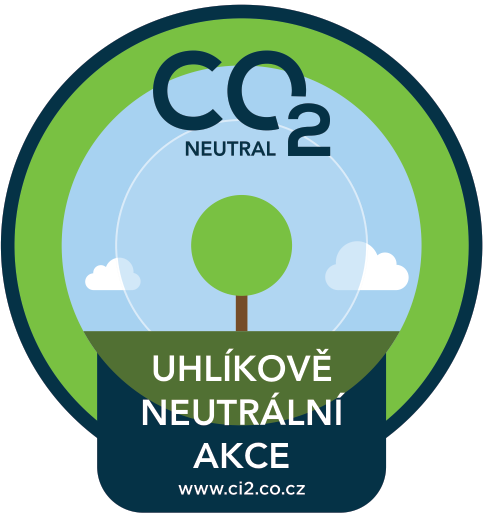Carbon-neutral events

Determining the carbon footprint of an enterprise or institution is more relevant than ever; related to this topic is the emergence of a new trend – calculating the carbon footprint of particular events. Today, event-organisers are increasingly interested in climate protection, and especially carbon footprints – an integral element of any efficient climate protection measure. Managers thus often have to ask themselves the question, “how can we deal with produced greenhouse gas emissions”, and relatedly, what is it that they can do to
minimize or even totally eliminate produced emissions.
Thanks to targeted planning during the preparatory phase of an event, it is possible to avoid the production of emissions by adopting appropriate measures leading to emission reduction throughout the event. Then, the greenhouse gas emissions already produced can be further offset through dedicated projects in any region of the Czech Republic.
Subsequently, this action may be called "CARBON-NEUTRAL ACTION ".
STEPS TOWARDS A CARBON-NEUTRAL EVENT
0. THE DECISION TO ORGANIZE A CARBON-NEUTRAL EVENT
The Organising Committee must come to the decision to organize a carbon-neutral event.
1. CO2 EMISSION OPTIMISATION DURING THE PREPARATION OF THE EVENT
During the preparatory phase of the event, it is key to design optimal measures to decrease energy consumption, including while transporting participants and materials to and from the event. It is essential to take this step into account already during the initial preparatory phases of the event so that the event’s organizer is able to accommodate all low-carbon requirements. Once it is no longer possible to effectively decrease the number of emissions, the organizer must also be prepared to compensate the remaining greenhouse gases produced.
2. PROVISION OF SUPPORTING DOCUMENTS FOR THE EVENT’S CARBON FOOTPRINT CALCULATION
Once the greenhouse gases have been reduced to the extent possible, it is necessary to determine the carbon footprint of the event. The carbon footprint calculation comprises various data and information, which all contribute, to different extents, to the total volume of the greenhouse gas emissions produced during the event. Before the event is held (or after the event), the organizers are consulted to evaluate the scale and validity of the data necessary to produce an accurate calculation of the event’s carbon footprint.
Examples of data used to determine an event’s carbon footprint:
- General information about the event – a number of participants, duration of the event, venue
- Energy consumption related to event’s organization – electrical energy, heating and cooling systems, the use of renewable energy sources
- Participants’ transportation to the event – distance to be traveled, car-sharing, means of transport
- Participants’ accommodation – type and accommodation categories
- Catering – regional food products, meat and meatless meals
- Use of office supplies – recycled paper, toners
- PR materials for the event’s participants – choice of appropriate materials and objects
- Side events – excursions, evening program, etc.
3. COMPENSATION OF THE EVENT‘S CARBON FOOTPRINT
It is necessary to compensate for the event’s carbon footprint, expressed in the form of CO2 emissions. The compensation is done via a chosen offsetting project. The organizer of the event finances a portion of a chosen project; oftentimes, for example, tree-planting activities. These projects are carefully selected and realized in municipal authorities and cities across the Czech Republic, demonstrably leading – now and in the future – to the extraction of an adequate amount of CO2 from the atmosphere. The project must guarantee that at least the same amount of emissions will be removed as were produced by the event.
These carbon offsetting projects are realized under the MONITORING/REDUCING CO2 program.
Once the size of the footprint is determined and the remaining emissions are offset, the organizer of the event obtains a CARBON-NEUTRAL EVENT certificate.
THE ADVANTAGES OF ORGANISING A CARBON-NEUTRAL EVENT
- Global responsibility. The event’s organizers openly respond to the need of having a carbon-neutral society and constructively support this goal.
- Optimising funding costs. The analysis of carbon footprint data allows for the identification of mainly energy reserves and potential savings that would help improve the efficiency of event organization for both the event’s organizers and the proprietor of the premises.
- The image and the organizers’ PR. Active involvement in climate protection is a sign of quality and responsibility towards the event’s participants and other actors.
- The coherence of the enterprise’s CSR strategy. The carbon-neutral event complements the enterprise’s other CSR events.
- Helping regions, cities, and municipalities. By supporting a public offsetting project and its realization, the quality of life and the environment of a specific territory in the Czech Republic will be enhanced.
Examples of offsetting projects realized under the MONITORING/REDUCING CO2 program
- Conference “We are Creating Future’s Climate”, January 26 - 27, 2016 in Liberec, organized by CI2, o.p.s.
- Managerial conference of SKANSKA, March 2016 – an offsetting project realized under the project “Landscape-Forming Orchard Blížkovice – Žlebouš”.
- Conference “Sustainable City 2016”, December 2016 – national conference of the network Healthy Cities in the Czech Republic.
- Conference of Director-Generals of the Vienna Insurance Group, Prague, October 2017.
